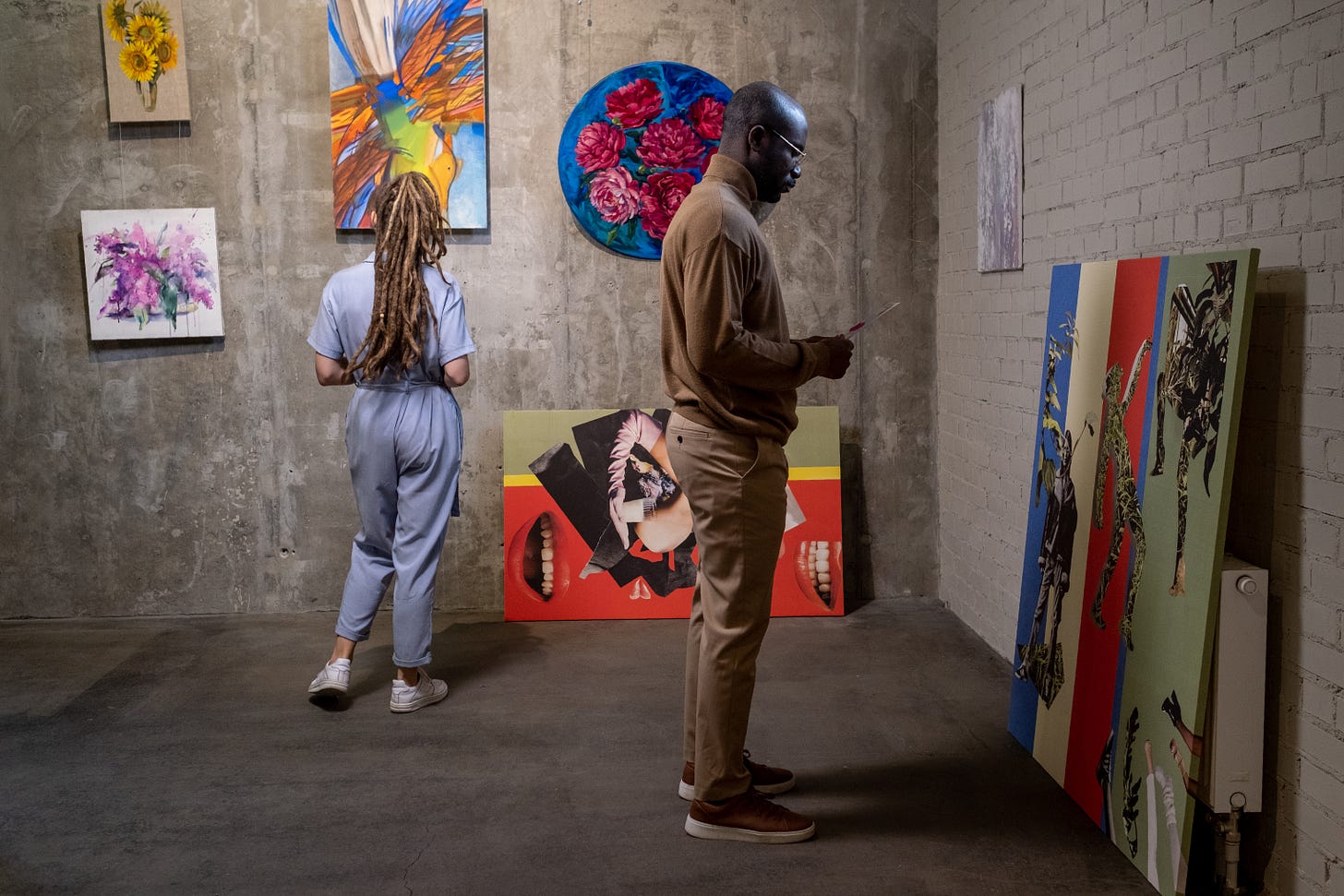Trump's Edict of Diversity in the Arts Hits Differently for Black Organizations
Already overlooked and underfunded, Black organizations say the NEA's new anti-DEI rules for federal funding won't stop them from doing what they've always done — make a way where there is no way.
When the National Endowment of the Arts posted on its website in February new federal funding rules targeting diversity and inclusion efforts at cultural arts organizations, the panic that ensued was palpable. That feeling only escalated when President Trump subsequently named himself chairman of the John F. Kennedy Center for the Performing Arts.
The NEA announcement states that any organization applying for federal funding cannot “operate any programs promoting ‘diversity, equity, and inclusion’ (DEI) that violate any applicable Federal anti-discrimination laws.” Further, it reads that the funds “shall not be used to promote gender ideology” and that any violation of those terms is grounds for the NEA suspending, terminating and/or recovering the funds.
Groups like Americans for the Arts, whose CEO told NPR that organizations immediately wondered, "How an application to celebrate Black History Month [would] be received?" were among the first to lead a chorus of outcries. Seven organizations, including PEN America, also banded together to write a letter that, in part, calls the executive order guidelines “propaganda.” It describes them as “an alarming departure from the fundamental democratic principles that the government may not interfere with artistic expression because of hostility toward its viewpoint.”
But not everyone feels that same sense of alarm or powerlessness. For Black artists, organizations and educators, the response to the new NEA regulations sounds very familiar.
“If you are a Black artist who's worked in Black spaces, this doesn't feel as sharp as I think people want to make it seem,” William Miles, an assistant professor of theater and performance at Purchase University, told me. “Because you've already been underfunded by the NEA.”
As with any Black-owned operation in every industry, Black arts organizations remain as overlooked and undersupported as they’ve ever been — particularly by the government. While the so-called racial reckoning of 2020 put a spotlight on that issue, it was still primarily white arts organizations that benefited from the boost of funds for their D.E.I. efforts (ranging into as much as millions of dollars), which, for some, were only newly instated at the time.
“Even if you get the big grant or you enjoy the fruits of that big wave of white guilt money in 2020, it's not yet a reliable part of sustaining your operation,” Miles continued. “So, I think that there's disappointment, of course. But [the executive order] wasn't particularly destabilizing.”
Not when, as Miles put it, they weren’t going to get the “little $20,000” anyway. “It's like, girl, I'm annoyed. I have to figure shit out.”
That rang true for Sharonda Richardson, a curator, arts educator and nonprofit owner of an arts organization in Florida. Her organization receives grants from a variety of sources, including the NEA and the National Endowment for the Humanities, which help with things like arts research.
She's all too familiar with the precarity of federal funding for Black arts organizations like her own. “I got a $30,000 grant,” she recalled. “And then COVID hit and they took it back. We’re like, ‘Wait a minute. We just spent the last four years taking advantage of the companies that were taking advantage of us. And now, it's like, [a] take back.’”
The new executive orders were just another example of that.
Richardson, like many others in the arts, received an email blast from the NEA about the changes. “As I was reading it, I was just shaking my head,” she remembered. But then she got to work.
The first question Richardson grappled with was a tricky one: How do you restructure curricula and programs so that they can still be funded, despite not actually changing a thing about them?
“I started to think about rewording,” Richardson explained. “Like, instead of saying, ‘I'm certified in D.E.I.,’ it might be, ‘I offer sensitivity training’ or ‘cultural training,’ something to not use the stigmatized word that administration has made it.”
She's effectively talking about code-switching on a proposal. Does she feel a kind of way about being an owner of an organization by and for Black artists and lovers, one she describes as “biggity Black,” and having to now do this?
“Of course, nobody wants to not let the world know that we represent marginalized voices and under-told stories and cultural experiences,” Richardson said. “However, what I have learned from working with white people is that it's all about what you say and how you say it.”
After our call, she emailed me this recent Forbes article, which isn’t exactly about the new NEA guidelines but rather the executive orders targeting funding proposals for the National Institutes of Health and the National Science Foundation, which are dealing with a similar issue. Terms like “barrier,” “anti-racism,” “disabilities” and “LGBTQ” are considered red flags. (Coincidentally, the phrase “cultural sensitivity,” a version of Richardson's projected self-corrective, is also on that list).
What Richardson was suggesting is that organizations craftily avoid those types of words (Forbes lists a whopping 197 of them). “They'd have to learn the language to use without changing the actual program because this resident dump is insane,” she stated in her email.
Essentially, they need to be “stealthy,” which is a word Miles used in his response to the largely white-owned organizations lamenting the new guidelines. Both he and Richardson made the point that just because you can’t use a word like “Black” in a proposal or promotion for an arts performance doesn’t mean that that Black and/or female-led project then needs to be canceled.
“Like, OK girl, the women's initiative is gone, but I can still produce that play,” Miles said. “With these mandates, it's like, if your commitment is to these artists, there's not necessarily a mandate saying you only have to teach or produce white plays or white works.”
With that, Miles raised an important question: Is there, or was there ever, a commitment to Black artists if intimidation from the government over the use of certain terms in their promotion is all it takes to completely dismantle it?
“I think that there's an opportunity to be stealthy,” Miles said, “that, if I'm operating from my most optimistic place, is a missed opportunity, if I'm operating from my most pragmatic place, is revealing the inherent white supremacy of the arts in America on the liberal side.”
But many mainstream organizations are too busy scrambling to come up with a way to play the system and subsequently expose its biases. That’s something Black arts organizations, like all Black folks in this country throughout history, have always had to know how to do.
So, the NEA rules didn’t exactly feel like the threat they were to so many white-led organizations. The very idea of Trump’s anti-D.E.I agenda hits differently for Black arts spaces that inherently serve diverse audiences. Because they don’t need an initiative to promote inclusion in the arts when inclusion is already their entire purpose.
As Richardson put it, “DEI is a white woman's game. We have always done this. Our applications have always looked like that. It's really their problem to have.”
That’s partly why Michelle Lang-Raymond barely batted an eye when she first heard about the new NEA rules on the news. She is the founder and executive director of Acts on Stage, a Seattle-based theater company that focuses on increasing opportunities for Black and brown artists and activists of faith.
“In my organization, my race is absolutely on mission,” she said. “So, I feel like if you are a Black person in a predominantly white institution, this definitely matters to you more than it matters to me. We exist as a response to the systemic racism in the arts and culture world.”
While she sympathizes with the organizations that have made the “hard choice” to amend their programming to the new NEA rules, because “not everybody has the responsibility of people's livelihoods and whether they can continue to exist,” Acts on Stage has not been in that position.
“It's not a significant concern to us yet because we don't receive funding to the degree that if that funding stopped,” Lang-Raymond explained, “it [would] change anything about us.”
Hers is another Black arts organization that doesn’t receive much federal funding. In fact, the initial funding for Acts on Stage came from a church in the form of a million-dollar grant.
But she often watches the news about Trump’s executive orders not with a sense of panic but rather a curiosity and distant concern that one of these days one could actually impact her.
“Because, at some point, a ripple will reach you,” Lang-Raymond said. “And so it just sort of made me wonder: When and to what degree does that ripple reach us?”
Some of that, she continued, could materialize in the type of grants Acts on Stage receives. Like Richardson, Lang-Raymond has experienced being marginalized in the federal funding system. She recalled a “huge” grant from the Biller Family Foundation that she and her team tried and failed to get that was for theaters doing D.E.I. work, because their organization didn’t match the budget qualifications.
“You had to be, like, a $5 million organization,” she said. “And the thing that sucks about that is that a $5 million theater is a large theater. A lot of people like me and Acts on Stage — we're not on a $5 million annual budget yet.”
That’s true for many Black arts organizations.
“So, you have a huge pot of money to give to theaters doing D.E.I. kind of work,” Lang-Raymond added. “Unfortunately, those are going to be mostly white theaters doing D.E.I. work as opposed to theaters of color run by people of color who are doing exactly that.”
But what Lang-Raymond and other Black founders are thinking about is if the biller or other grant source surrenders to government intimidation by no longer making D.E.I. (or however you want to reframe that) a priority that could impact their potential for funding.
With that concern in mind, how is she preparing for that kind of ripple?
“I don't say this proudly,” she admitted, “I think organizations like ours are so in the thick of the day-to-day administration of our work that we have not yet moved into a response to it.”
That’s only partially true. Combating challenges like this is already baked into the mission of Acts on Stage: Being for the people and turning to them in times of need. Since its opening, Acts on Stage introduces each show with Lang-Raymond herself sharing its “million-dollar startup story” with the audience, with the understanding that that grant will eventually run out.
“Our hope is that you'll become a patron and that you will be how we sustain,” she explained. “I'm giving that speech more emphatically [now] because I'm saying, ‘We are in your hands.’ We would rather be in your hands than in the hands of the federal government.”
And there are plenty of alternatives to federal funding, as many Black arts organizations had to quickly learn and off which many continue to thrive. While they feel challenged in some ways, they also recognize that no edict from the Trump administration has explicitly stated that they or their projects can’t exist — and just as Black as they’ve ever been.
“You're gonna fund me knowing I'm Black,” Richardson said. “When you see these cities come across your desk, you know exactly who it’s servicing. So, I feel challenged to create work that still showcases our Blackness but also forces them to give me money.”







Always inspiring to be reminded of whose anxiety it really is!
Thanks for this remembered wisdom.